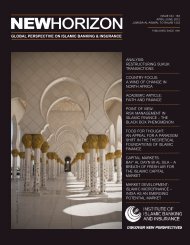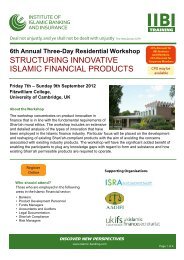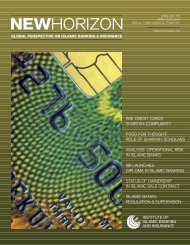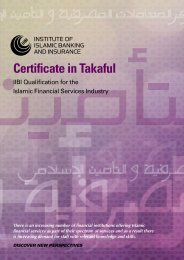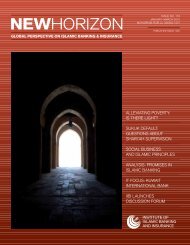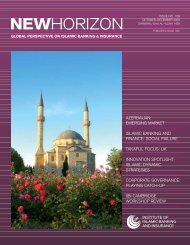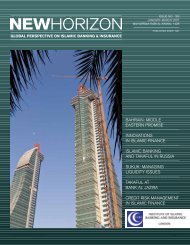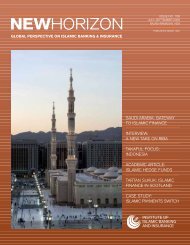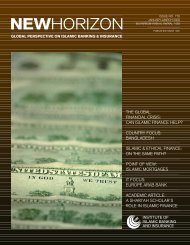NEWHORIZON
NEWHORIZON - Institute of Islamic Banking and Insurance
NEWHORIZON - Institute of Islamic Banking and Insurance
- No tags were found...
Create successful ePaper yourself
Turn your PDF publications into a flip-book with our unique Google optimized e-Paper software.
<strong>NEWHORIZON</strong> April to June 2013<br />
ANALYSIS<br />
The Subprime Crisis and the Lessons<br />
for the Islamic Finance Industry<br />
By: Suleman Muhammad Ali, Manager- Product Structuring & Research;<br />
Product Development and Shar’iah Compliance, Meezan Bank Limited<br />
Background<br />
The subprime mortgage crisis is<br />
ongoing. It started in the United<br />
States and was characterised among<br />
other things by evaporating liquidity<br />
in the world’s credit markets,<br />
declining asset prices especially in<br />
the housing sector, high rates of<br />
foreclosures on mortgage assets<br />
and the failure of mortgage-backed<br />
securities. Although the crisis<br />
started in the United States its<br />
effects have been contagious and<br />
have extended to other financial<br />
markets around the globe.<br />
Factors Leading to the Financial<br />
Crisis<br />
The crisis started when the US<br />
housing asset price bubble started<br />
to burst. US housing asset prices<br />
had risen sharply during the five<br />
years up to 2006. During the<br />
period of the bubble more and<br />
more people were encouraged to<br />
borrow money at low interest rates<br />
by various financial institutions.<br />
Adjustable Rate Mortgages (ARM)<br />
were offered by numerous banks<br />
under which mortgage loans were<br />
available at very low initial interest<br />
rates, with a pre-agreed increase<br />
after a certain period, for instance<br />
after two to three years. Similarly<br />
mortgage loans were offered on<br />
very easy terms or with minimal<br />
credit appraisal requirements often<br />
flouting the process of adequately<br />
checking the assets or the existing/<br />
future income streams of the<br />
borrowers. All of these efforts were<br />
geared towards encouraging more<br />
and more borrowing to acquire<br />
residential property.<br />
The High Consumption<br />
Mindset<br />
Similarly the long-term trend of<br />
rising prices encouraged more<br />
and more home owners to use the<br />
increased value of their homes<br />
as security for getting a second<br />
mortgage or credit for financing<br />
their consumption expenditures<br />
or for financing investments in the<br />
stock market. In 2008 the average<br />
US household debt was around<br />
134% of disposable income and<br />
the total nationwide household<br />
debt was $14.5 trillion according<br />
to US government statistics. All<br />
these figures show that the average<br />
American was consuming more<br />
than he or she was earning. How<br />
is it possible for anyone to spend<br />
more than they are earning? The<br />
answer lies in incurring debt to<br />
finance consumption expenditure.<br />
All this was due to low credit rates,<br />
easy or zero-credit application<br />
terms and the increasing value of<br />
the underlying mortgaged assets.<br />
Bad Credit Practices and<br />
Subprime Lending<br />
In the years leading up to the<br />
crisis the US economy had seen<br />
unprecedented growth, which in<br />
turn resulted in high capital inflows<br />
from the growing economies of<br />
Asia and from elsewhere around<br />
the world as the US was seen<br />
as a safe haven for investment.<br />
The money that was coming<br />
in resulted in a high supply of<br />
liquidity. This coupled with lower<br />
interest rates and the high rate of<br />
origination of mortgage-backed<br />
securities produced a mindset in<br />
which banks were more eager to<br />
service large volumes of credit<br />
applications in shorter time spans<br />
rather than focusing on ensuring<br />
the quality of the credit. The<br />
result was the emergence of<br />
various schemes allowing credit<br />
to individuals with an impaired<br />
or no credit history. Automated<br />
credit application schemes based<br />
on concepts such as NINA (No<br />
Income No Assets) basically<br />
allowed borrowers to apply for<br />
and get credit without showing<br />
any proof of employment or<br />
assets. Credit was, therefore, given<br />
without taking into consideration<br />
the ability of the borrower to<br />
make repayments. This was also<br />
partly prompted by the greed and<br />
short sightedness of those bank<br />
managers, who were keen to inflate<br />
their performance by showing high<br />
credit disbursements in the hope<br />
of getting short-term benefits and<br />
high-performance bonuses.<br />
The Case of Mortgage-Backed<br />
Securities (MBS)<br />
Mortgage-backed securities are<br />
underpinned by the earnings or the<br />
cash flows from various mortgage<br />
loans. The payment, return and<br />
the security are all tied up in these<br />
mortgage loans. It is a product<br />
created through modern financial<br />
engineering, which allows various<br />
banks to pass on their credit<br />
exposures to other banks and<br />
financial institutions or individuals<br />
by repackaging the original<br />
mortgage loans into securities or<br />
bonds representing an ownership<br />
or security interest in these<br />
mortgage loans. The previous<br />
mortgage or lending model<br />
envisaged that the banks originating<br />
the loans would hold on to them<br />
until maturity; however, with the<br />
engineering of securitisation, banks<br />
were able to originate and distribute<br />
the loans to other entities by<br />
repackaging them into securities.<br />
This had two detrimental effects on<br />
the US financial market. Firstly it<br />
resulted in the availability of excess<br />
liquidity to the credit markets.<br />
Banks were able to originate the<br />
loans through their deposits and<br />
then sell these loans throughout<br />
the world by repackaging them<br />
into securities thereby releasing<br />
the liquidity tied up in the original<br />
loans to finance yet further<br />
mortgages and loans.<br />
Secondly the policy of originate<br />
and distribute led to the moral<br />
hazard problem and encouraged<br />
the banks and investment banks<br />
to originate high volumes of<br />
mortgage loans with little emphasis<br />
on the credit quality of such loans<br />
since their focus was short term<br />
in nature, i.e. to earn large profits<br />
through origination fees; fees for<br />
structuring complex mortgagebacked<br />
securities and profits from<br />
the sale of such securities. These<br />
banks and investment banks were<br />
not concerned about the longterm<br />
quality and results of such<br />
securities or the defaults that would<br />
arise if housing prices started to<br />
fall. The structuring managers<br />
were appraised and were paid<br />
substantial bonuses on the basis of<br />
the various complex securitisation<br />
structures of MBS that they were<br />
able to sell successfully and the<br />
www.islamic-banking.com IIBI 15



